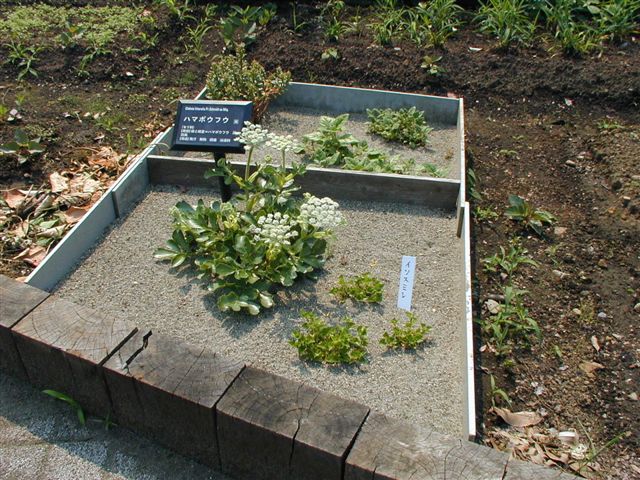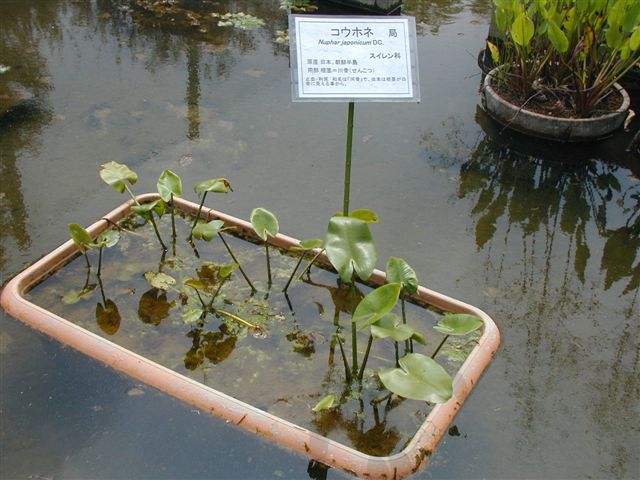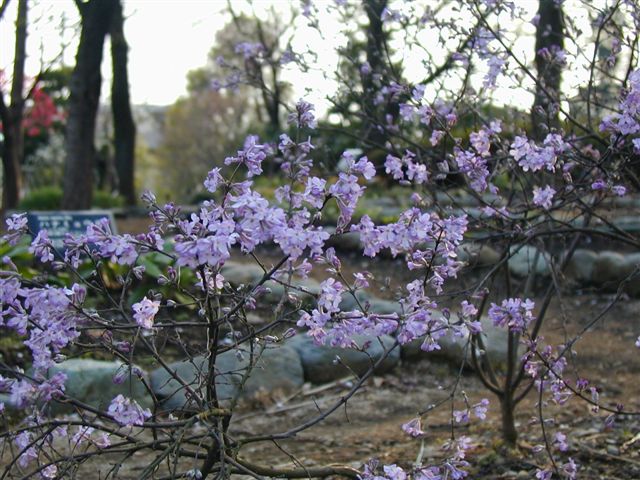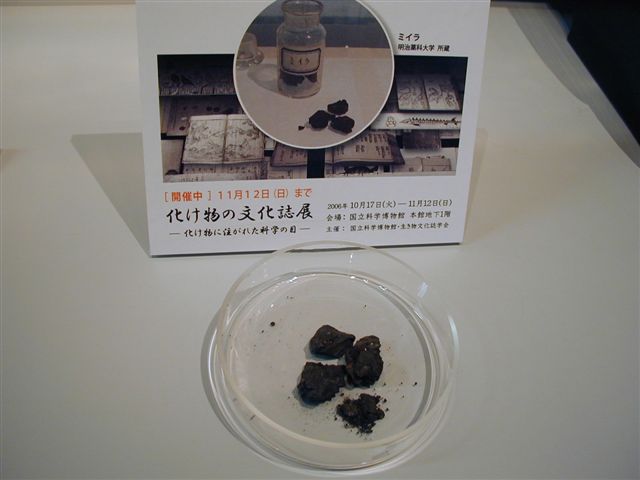


Medicinal Plant Garden, Meiji Pharmaceutical University
| Director: | Masaki Baba, Associate Professor, Department of Clinikal Kampo Medicine |
| Location: | 2-522-1 Noshio, Kiyose, Tokyo 204-8588,Japan |
| Telephone: | 042-495-8913 |
| Directions: | About 12 minutes walk from Akitsu Station, Seibu Ikebukuro Line About 17 minutes walk from Shin-Akitsu Station, JR Musashino Line |
| Closed: | Sundays, National holidays, University holidays |
| Opening Hours: | 9:00-17:00(16:00 in winter) |
| For visitors: | Please stop at the university gatehouse at the main gate or the east gate to visit the garden. A reservation is required for a group of more than 10 peoples. |
Meiji Pharmaceutical University consists of a Graduate School (courses of Pharmaceutical Sciences, Clinical Pharmacy and Affiliated Graduate school), and the Faculty of Pharmacy and Pharmaceutical Sciences. In 2006, when the undergraduate program was switched from a 4-year system to a 6-year system, the university established the Department of Pharmacy and Health Sciences (6-year course) and the Department of Life and Pharmaceutical Sciences (4-year course). This private pharmaceutical university proudly cerebrated its distinguished 100th birthday in 2002.
In the Medicinal Plant Garden at Kiyose Campus located in the suburb of Tokyo, a variety of plants, including original plants of herbal medicine listed in the Japanese Pharmacopoeia, have been planted and displayed. Many varied trees have been also planted within the campus, among them, there are medicinal trees such as Prunus armeniaca, Picrasma quassioides and Phellodendron amurense, the origin of Phellodendri Cortex which is significant as herbal medicine.
Before relocating to the present-day campus, we had medicinal plant gardens on two campuses in Tokyo. They were affiliated to the universtiy for the purpose of pharmaceutical education and research.
In 1998, when the campuses were integrated and moved to Kiyose, the Medicinal Plant Garden was reconstructed on the new campus.
The biggest portion of the garden consists of a specimen garden and an area for cultivation. The specimen garden has been used for the study of pharmacognosy, the core subject of the Department of Pharmacy and Pharmaceutical Sciences. It has provided hands-on practice for its students and faculty as well. The cultivating area exists for research purposes. Additionally our activities have been recently focused on encouraging and fostering interests in medicinal plants within the local community.
The Medicinal Plant Garden, which boasts a total area of 920ću, contains three sections on the campus, one of which is the major garden for specimens that is situated on the right of the main entrance . The area around the main entrance and the Medicinal Plant Garden is called the "Meiyaku Woods", because of its abundance of trees and flowers in the area. It is a relaxing place that is open to the public.ü@
The largest section is mainly comprised of original plants of herbal medicines listed on the Japanese Pharmacopoeia, and medicinal plants used for ethnomedical. A shady section contains many varieties of mountain grasses. Our garden offers attractive aspects to people who visit in different seasons. Glehnia littoralis, Cnidium japonicum and Viola grayi are also cultivated in a small sandy soil area.

Hamabouhu, Glehnia littoralis
About 20 types of water plants such as Nuphar japonicum and Sagittaria trifolia are cultivated as well.
Kouhone, Nuphar japonicum
In a herbal garden, twenty varieties of herbs like Lavandula angustifolia , Rosmarinus officinalis and Origanum vulgare are growing, and fascinate our university students. Students sometimes sit and have lunch on the benches in the garden.
The primary educational purpose of the Medicinal Plant Garden is to have students learn the history of pharmaceutical sciences through lectures and hands-on practice. In addition it gives our students the opportunities to observe or cultivate medicinal plants which are regarded as a significant resource material for medicines, and the origin of herbal plants. A considerable number of medicines and pharmaceutical agents have been related with plants. For example, an effective ingredient from plant materials produces medicine, whereas Chinese medicine often uses unrefined natural plants in their raw or natural forms. The Medicinal Plant Garden has promoted the spread of education and knowledge about traditional medicine such as herbal medicine, herbs and Chinese medicine. The target is not only for our students but for the general public who are interested in traditional medicine. Medicinal plants and herbal medicine are deeply ingrained within our daily life. Especially the recent popularity of healthy living has boosted the interests of Kampo(Japanese herbal medicine) or medicinal plants, from a viewpoint of self-medication and preventive medicine.
Along with the switch-over to the 6-year program of pharmaceutical sciences, the Department of Pharmacy and Health Sciences required students to take a clinical practice at hospitals and pharmacies. And a 6-months-special course which includes 7 selective programs is also offered to 5th graders. The course is a project that provides high quality education for specialists in pharmacy, along with helping students plan for their future. Among the 7 courses, it is "a course for traditional medicinal pharmacy" that puts emphasis on hands-on practice at the Medicinal Plant Garden, so that the program can further to educate students who have a basic knowledge about traditional medicine such as Kampo and medicinal herbs. Therefore, we have recognized the increasing importance of the Medicinal Plant Garden to the university.
Education about Kampo medicine should play a bigger role in pharmaceutical sciences. Knowledge and understanding of the specimen of herbal medicine, the source of drug, and their origin of plants will need to be further acquired more than it is now. Oriental medicine like Kampo is presently becoming well received within the faculty of medicine, therefore pharmaceutical education is now seeking to garner a closer relationship with herbal medicine.
People have utilized various kinds of plants to cope with diseases so far. After much trial and error, we have found effective medicine through contemporary herbal medicine. Today there have been a number of unknown medicines capable of creating a new drug, most of which have not yet been genetically identified. Furthermore, with the discovery of lead compounds in the development of medicinal products, research for natural medicine resources is still significant and attractive.
We do not conduct original research, because the Medicinal Plant Garden is independent from the research laboratories. However, the Medicinal Plant Garden has supported research carried out by laboratories in the departments, by cultivating and maintaining plants which are being experimented with. Those plants include Genuflexus, the origin of "Daphne genkwa" which is listed in the collection of medicinal herbs in Shoso-in(the wooden storehouse of Todaiji Temple, the national treasures of Japan , constructed in the 8th century). The collection of herbal medicine in Shoso-in is a research source for the Department of Natural Medicine and Phytochemistry. Study in trying to find saponin from the plant family of Cuctaceae, conducted by the Department of Pharmacognosy and Phytochemistry, are also supported by the garden in cultivating plants for the research.

Fujimodoki, Genuflexus
The plants related to other research include Zihuaqianhu, an origin of Angelica decursiva.Japan Pharmacists Education Center has promoted "Training courses for certification in the use of Chinese herbal medicine and natural drugs". This is one of the center's continuing education program which is conducted in cooperation with the Japanese Society of Pharmacognosy. In this course, trainees have to take a one-year lecture course as well undergo hands-on practice in the medicinal plant gardens so that they will be eligible for the exam. Meiji Pharmaceutical Medicinal Plant Garden is among those cooperating gardens to accept trainees for practical observation. In addition, our garden is used to facilitate a "Community College Course"(formerly referred to as "Living with Kampo & Herb course ")
The university allows the Medicinal Plant Garden to be used as walking path during "Kiyose Katakuri(Erythronium japonicum) Festival", which is the annual event held at the beginning of April by Kiyose city. Erythronium japonicum and Anemone flaccida are found all around the campus, and people enjoy the wonderful natural environment. Even now, small wooded areas are scattered throughout Kiyose city, with an abundance of nature, including a habitat of fireflies. The Medicinal Plant Garden is also used for group tours from various fields as well as being utilized as a training site. The Meiji Pharmaceutical Plant Garden has been part of the Japan Association of Botanical Gardens since 1981. The association aims to develop and promote the botanical garden industry, through maintaining and enhancing close ties with relevant organizations. Considering this background, our garden will need to foster educational commitments to the wider community as a place for lifelong education.
Recent global environmental destruction has caused many species including plant resources to become extinct or endangered. So we have to put emphasis on our garden to conserve not only medicinal plants but significant genetic resources of plants.
The area by the main entrance, near the Medicinal Plant Garden, is called Meiyaku Woods, where a row of Zelkoba trees and seasonal plants and flowers are planted. It is open to the public. In 1983, the imperial prince Mikasanomiya Takahito, a brother of Showa Emperor, planted camellia on the former campus of the university. Now the camellia tree has been transplanted at the Meiyaku Woods.
The Meiyaku Museum was founded on the former campus in 1982, for the commemoration of the 80 year history of the university. The museum has three missions. The first is recognizing the great achievements of Shigenobu Onda (Pen name Godo), the founder of the university.
The second is preserving and storing historical materials and documents of the university. The third is contributing to the pharmaceutical education by extensively collecting materials related to pharmaceutical sciences and displaying them. When the museum was reconstructed at the time of relocating the campus to Kiyose, the museum enhanced its display, with lots of specimen of medicinal herbs which had been collected in the Department of Pharmacognogy and laboratory of Biology.
The museum contains objects related to the founder, Dr.Onda, and "The Ohara Pharmaceutical Collection". The collection includes old pharmaceutical equipment and articles donated by a pharmacist, Mr. Ohara. The tools were used in a pharmacy dating back about 200 years. Parts of the collection is on public display now.
The museum provides a room for a permanent exhibition and meetings. There are videos available in the meeting room, as well as displaying of a variety of herbs.
Taking the opportunity of moving to the area of Musashino, a suburb of Tokyo, the museum has also introduced 10 local species of medicinal herbs and trees as mentioned on the sign board with the title of "Medicinal plants in Musashino". The board gives a brief explanation for such plants as Corydalis lineariloba,Zanthoxylum piperitum and Epimediuim marcranthum var. violaceum.
The museum housed herbal medicine which include Glycyrrhiza uralensis, Rheum palmatum and other different species as well. A well-structured-display helps visitors understand how herbal medicine is utilized for Kampo.
The museum also displays crude drug from animal products such as a unicorn's tusk, a rhinocero's horn, a buck's horn, and rare products which are today unable to be obtained under the condition of the Washington Pact. Components and usage are written on the sign board. Among traditional medicine produced by animals displayed in the museum, there are other valuable things such as Pangolin manis, Hippocampus coronatus and Gecko gecko. A mummy was loaned to the National Museum of Nature and Science for the exhibition,"Cultural Records about Specters",held in November, 2006 and "Medicine as a Philanthropic Art" held in March-June, 2014.

Miira, Mummy
The museum displays facsimile editions of classical books on pharmacy and medicine from overseas as well. The books include the complete works of Hippoctates, codex Vindobonensis, and a Japanese old medical book "Kaitaishinsho, Tafel Anatomie" (the first legitimate work on Western medicine translated into Japanese), and "The Beginning of Dutch Learning".
Medicinal Plant Garden and Meiyaku Museum are open to the public. They have lots of visitors during Open Campus and University Festival. A brochure of the museum, including lists of display items and medicinal herbs, are available for visitors.